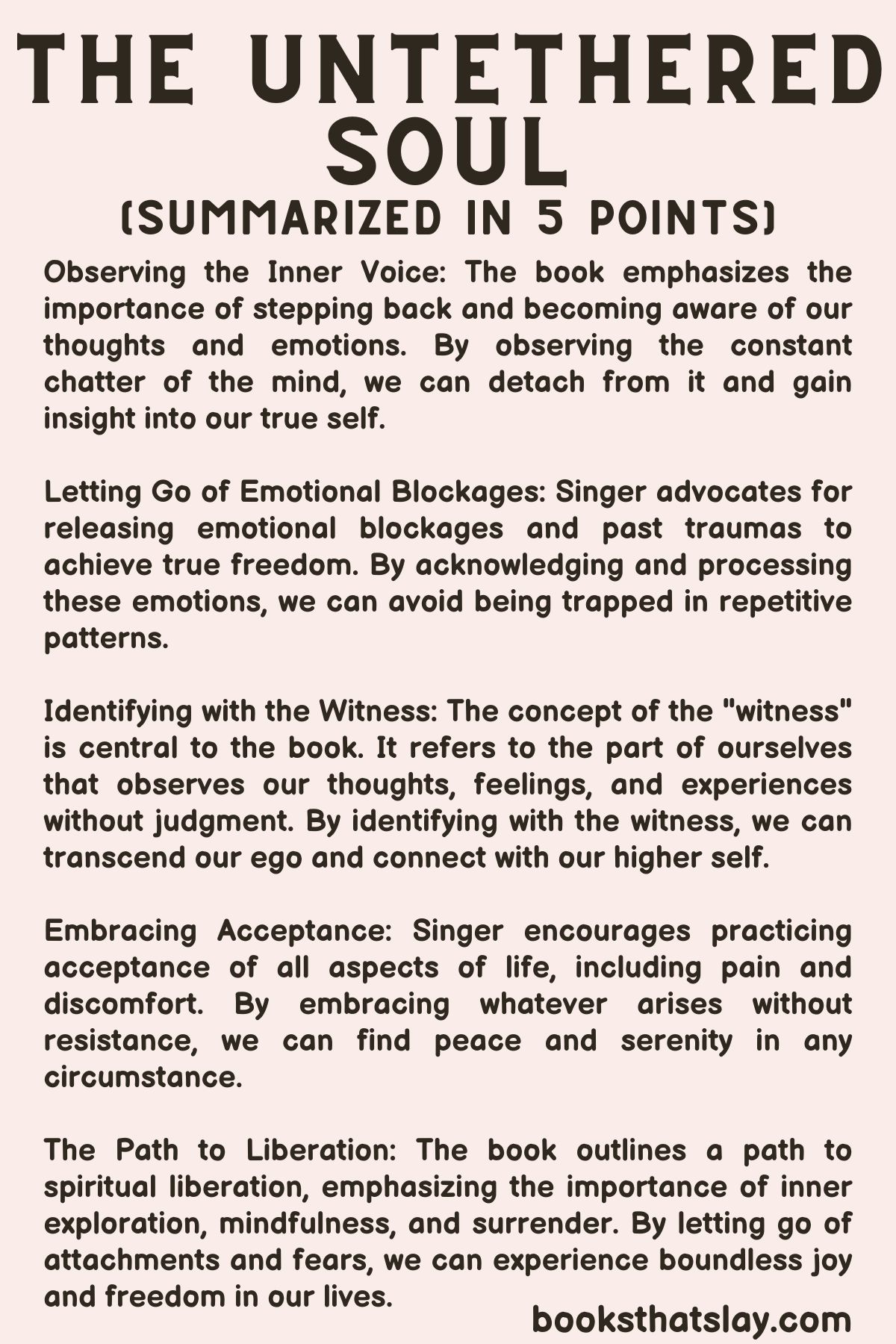The Untethered Soul | Book Summary
“The Untethered Soul: The Journey Beyond Yourself” by Michael A. Singer is a spiritual self-help book that guides readers towards understanding their identity, their relationship with their thoughts, emotions, and the external world, and ultimately helps them find inner peace.
The Untethered Soul Summary
The book is divided into five parts:
1. Part One: Awakening Consciousness
This section starts with the key question: “Who are you?”
The author invites us to look at their thoughts and emotions from a detached, observer-like perspective. He emphasizes that you are not your thoughts, feelings, or experiences.
Instead, you are the conscious observer of these phenomena.
Singer provides techniques to aid readers in separating their true selves from their thoughts and emotions, like watching them pass by as events happening outside of the self.
2. Part Two: Experiencing Energy
Singer notes that blocked personal energy can lead to feelings of discomfort or even pain.
This part stresses the importance of letting experiences flow through you rather than hoarding them in your heart and mind.
This can be achieved through mindfulness and openness, accepting whatever life brings without trying to resist or control it.
3. Part Three: Freeing Yourself
This section delves into the idea that your experiences and reactions are not you—they’re simply experiences and reactions.
The author discusses the process of letting go of painful experiences and emotions instead of holding onto them. He talks about how clinging to or resisting these can cause emotional blocks, while releasing them allows for spiritual growth and freedom.
4. Part Four: Going Beyond
Singer focuses on the idea of transcending personal limits to connect with the infinite energy of the universe.
The author discusses the concept of God from a non-religious perspective, describing it as the universal energy and consciousness. He also introduces the idea of the “inner thorn,” which represents our deeply-rooted fears and insecurities.
By confronting these inner thorns directly, we can go beyond our perceived limitations and experience profound personal growth.
5. Part Five: Living Life
The final section of the book is about applying the teachings from the previous sections to everyday life.
It emphasizes living in the present moment, letting go of past regrets and future anxieties, and maintaining an open heart. Singer also discusses how to maintain equanimity in the face of life’s ups and downs.
The ultimate goal is to live a life of freedom, peace, and fulfillment, unencumbered by the trappings of the ego and societal expectations.

Also Read: Girl Wash Your Face | Book Summary
What can you learn from the book?
1. The Power of Inner Awareness and Self-Reflection
Singer emphasizes the power of being self-aware and encourages readers to become observers of their own internal dialogues and emotional reactions.
This helps in distinguishing between an individual’s true self (the silent observer) and the voices inside the head (our thoughts and emotions). Singer uses the metaphor of watching a movie in a theater to represent the idea of self-observation.
He suggests that much like the way we watch a movie, we can observe our thoughts and emotions without becoming entangled in them. By fostering this awareness, we can better understand our patterns and triggers, and ultimately gain control over them.
This teaches us to not let our emotions or thoughts control our actions and decisions, and instead respond from a place of calm and centeredness.
2. The Significance of Living in the Present
Singer argues that dwelling on past events or worrying about the future prevents us from fully experiencing the present moment.
He uses the example of driving a car – if our focus is on the rearview mirror (the past) or anxiously awaiting the destination (the future), we risk missing out on the journey itself (the present).
By learning to focus on the current moment, we can alleviate a significant amount of stress and anxiety. Singer recommends mindfulness and meditation as tools to help bring our attention back to the present.
Also Read: The Millionaire Fastlane | Book Summary
3. The Role of Energy in Personal Development
The book discusses the concept of energy as a vital force that flows within us, and how blockages in this energy can lead to emotional disruptions and dissatisfaction in life.
Singer uses the analogy of a blocked river to depict a person with pent-up emotions or unresolved issues. Just as a river must flow freely to be healthy, so must our energy.
To free this energy, Singer suggests that we should let our experiences pass through us without resistance – whether they are good or bad.
By not clinging to positive experiences or rejecting negative ones, we can maintain the free flow of our inner energy and cultivate a more balanced and harmonious life.
4. The Journey Towards Personal Freedom
Throughout the book, Singer illustrates that personal freedom and inner peace come from understanding and accepting the impermanence of all experiences.
Our tendency to grasp onto the good moments and resist the bad ones binds us in a cycle of pleasure and pain. The ultimate lesson from this is that we can free ourselves from this cycle by accepting every experience just as it is, without attempting to change it or push it away.
This acceptance not only brings inner peace but also fosters a state of unshakeable serenity that remains stable regardless of external circumstances.
Final Thoughts
Throughout “The Untethered Soul,” Singer combines mindfulness practices, eastern spiritual wisdom, and personal insight to guide readers on a journey towards self-understanding and inner peace. His approachable language and practical advice have made the book popular among those seeking a modern, accessible introduction to spiritual growth and mindfulness.
Also Read: